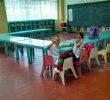Davao City — Consumer education is set to be taught to high school students not as a separate subject but integrated into their present curricula.
Carmen Avenda�o of the Bureau of Trade Regulation and Consumer Protection (BTRCP) of the Trade and Industry Department announced that 18 fair trade laws and the one town, one product (Otop) program will be integrated in secondary English, Filipino, Mathematics, Science, Araling Panlipunan, Music, Arts, Physical Education and Health (MAPEH), Technology and Livelihood Education (TLE), and Values Education subjects. Out of these topics, 97 lesson exemplars or patterns have been written.
During Avenda�o’s recent visit in Davao City for the Mindanao leg of the Teachers-Trainors’ Training, a demonstration on the integration of the consumer education was conducted at the Davao City National High School.
Avenda�o attended the teaching demonstration for Mathematics and was impressed with how the integration was handled.
“I wasn’t expecting that consumer education could be taught in Math. The teacher used geometric sequence. Ang ginawa niya na halimbawa ay ‘double-dead meat’, na ‘pag nakain mo ang ganito kaliit na piraso, ganito kadami ang bacteria na sisira sa kalusugan mo. Napakaganda talaga ng takbo ng klase. (The teacher used as an example ‘double dead meat’, that is you eat a certain size of it, there is an equivalent amount of bacteria that will be detrimental to your health. The lesson went very smoothly.) I was so impressed,” she said.
Avenda�o said that the curriculum integration will be done starting school year 2010-2011.
“We have to be fully prepared before we start with the implementation. We have to ensure that the effectiveness of the exemplars drafted have already been validated before SY 2010 comes,” she said.
Moreover, Avenda�o explained that the Mindanao leg of the training was geared towards the alignment and validation of the draft lesson exemplars.
Why high school students?
Avenda�o said that high school students are the most ideal target audience of the program since they already have developed a certain level of buying preference.
She added that with this level of buying preference, these students can already decide on their own – whether to buy this particular brand or the other.
“Teenagers nowadays are so hooked with pervasive media such as TV and the internet. They tend to believe on what they see in them. With the curriculum integration program, we can already teach our students how to become responsible consumers,” Avenda�o stressed.
Avenda�o is optimistic the program will gain positive results especially in molding the youth in becoming wise and vigilant consumers.
The Curriculum Integration program is jointly implemented by DTI and the Department of Education (DepEd). (DTI-PIA XI)










